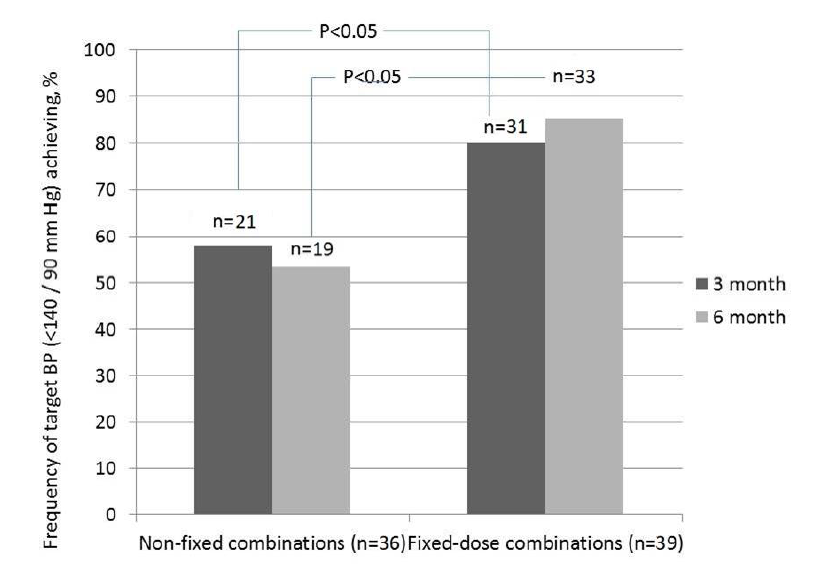Efficacy of fixed dose of triple combination of perindopril-indapamide-amlodipine in obese patients with moderate-to-severe arterial hypertension: an open-label 6-month study
DOI:
https://doi.org/10.15419/bmrat.v6i11.578Keywords:
abdominal obesity, antihypertensive therapy, arterial hypertension, fixed-dose combination of antihypertensive agents, non-fixed combination of antihypertensive agentsAbstract
Background: Arterial hypertension (AH) remains the most common cardiovascular (CV) risk factor worldwide.
Methods: Seventy five moderate-to-severe hypertensive patients with abdominal obesity aged from 48 to 66 years (45/30 men and women respectively) were selected from the entire cohort (n = 375) according to the inclusion and exclusion criteria. The patients were divided into two subgroups depending on the arm of antihypertensive therapy lines. The first subgroup of patients (n = 36) received a non-fixed combination of oral antihypertensive agents: perindopril (4–8 mg daily), indapamide (1.25–2.5 mg daily) and amlodopine (5–10 mg daily). The second subgroup of patients (n=39) received fixed-dosed combination of these antihypertensive agents aforementioned in the ranged doses (4 mg/1.25mg/5 mg; 4 mg/1.25mg/10 mg; 8 mg/2.5 mg/5 mg; 8 mg/2.5mg/10 mg) in the same manner. The examinations of the clinical status, office, and ambulatory blood pressure values were carried out at baseline in 3 and 6 months after study entry.
Results: The frequencies of BP target levels after treatment were higher in the fixed-dose combination group than in the non-fixed combination (at 3 months: 80% versus 58%, p<0.05 and at 6 months: 85% versus 53%, p<0.05). The adherence to triple fixed-dose combination was also higher in comparison with one to non-fixed combination (at 3 months: 82% versus 64%, p<0.05 and at 6 months: 87% versus 61%, p<0.05). It has been established that low-dose of perindopril/indapamide/amlodopine (4mg/1.25/10mg and 8mg/2.5/5mg) were used frequently in fixed-dose combination cohort of patients than in non-fixed combination (15% versus 0%, P<0.05, and 33% versus 19%, p<0.05, respectively). At the same time, maximum doses of these agents (8mg/2.5mg/10mg) were required for achieving target BP levels in a significantly lower proportion of patients receiving fixed-dose combination as compared to patients receiving non-fixed combination (52% versus 81%, p<0.05). Additionally, the triple fixed-dose combination has proved to be better in restoring ambulatory blood pressure monitoring profile than non-fixed combination.
Conclusion: Achievement of target blood pressure levels in patients with uncontrolled arterial hypertension and abdominal obesity was possible at lower doses of perindopril, indapamide, and amlodipine when used as a fixed-dose combination rather than non-fixed (free) combination.

Downloads
Published
Issue
Section
License
Copyright The Author(s) 2017. This article is published with open access by BioMedPress. This article is distributed under the terms of the Creative Commons Attribution License (CC-BY 4.0) which permits any use, distribution, and reproduction in any medium, provided the original author(s) and the source are credited.
